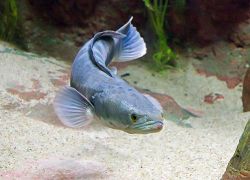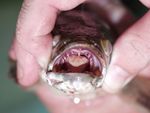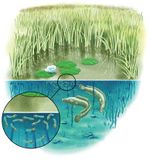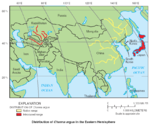Snakehead
| Snakehead |
|---|

|
| Scientific Classification |
|
| Genera |
|
Snakeheads are species of freshwater fish belonging to the taxonomic family Channidae. They are perhaps best known for an invasive species (Channa argus) in this group that was introduced into the U.S. as a food source from Asia. Unfortunately they did not fit in with in the other aquatic species. This made them a predator to many different organisms. After this was discovered, the snakeheads were announced illegal. [2]
These fish are are dark brown and can grow up to be 33 inches. It's called a snake head because of its pointed head. They can survive in a variety of different water, which exposes them to more aquatic life.[3]
Body Design
The bodies of the snakehead fish depend on their age and where they are located, but they usually grow to be at least 4 ft. long. The snakehead had been given its name based on its long snake shaped body and large scales that almost make it look like a snake. Its mouth is filled with many sharp teeth that are very canine-like. [4]
The snakehead fish may sometimes be confused with the native bowfin and burbot. The U.S. Fish and Wildlife Service helps with the identification between the snakehead and burbot or bowfin and shows how to compare the differences, but the snakehead should be pretty easy to identify because of its very distinguishing appearance. [5]
Life Cycle
The snakehead reproduces around June and July. When the female lays the eggs, it usually lays around 15,000 eggs at a time[6] Depending on the water temperature those eggs that the female lays, usually hatch in about 1-2 days[7]. While in the larvae stage, they are protected by both of the parents[6].
Larvae receive their nutrients from a yolk that they absorb by the time they are one third of an inch long. After the larvae stage, they feed on small crustaceans and other fish larvae. As they grow, they are a golden brown or a pale grey color. They become sexual when they are about two years old.[6]The snakehead is able to breathe air using the air bladder which allows them to breathe oxygen. Without the air bladder, they would just be normal fish that don't breathe oxygen. [8]
Ecology
In 1977, the first group of snakeheads was found at Silverwood Lake in California. They were introduced by Asian food importers. The first the people who found the species had not thought about it.The first population of it was identified in a pond behind a mall in Crofton, MD.[9]
These fish are invasive throughout the whole U.S. and there are four different species of it. Its native to some places in Asia, Africa, China, Korea, and Russia. Since the snakeheads are freshwater fish, they live in streams, rivers, wetlands, or ponds. They choose to live in water that are low moving waters. These fish can live through cold waters and places with low oxygen. Although ,during the spawning season the snakeheads, they like living in shallow waters.[10] They also like to live places with more vegetation for food and reproduction. [11]
The effects of this organisms vary in each place. Most of the effects were located in Hawaii and Australia. Many places in the U.S. have been affected by the four types of species. They can eat species on land and water. They compete with the other fishes for the location that their opponent has. Their energy flow cause the bringing of parasites and forms of diseases. They are classified as a predator to many fishes that are near them and will eat almost anything. [12] . These effects have a negative impact in the U.S.
Invasive Species
Location and Method of Introduction
The snakehead was first founded in Asia, but then is soon came to North America. the fish had been found in Crofton Pond, MD, in 2002. once it had landed in the U.S., it soon shifted over into Mexico and the Hudson Bay.[13] Some snakeheads had been established in the Potomac River in 2004 and some other places in the U.S. some of the states that the snakehead was spotted are in California, Delaware, Florida, Hawaii, Maine, Maryland, Massachusetts, and Rhode Island.[14] One of the types of snakeheads called the bullseye snakehead[15] has been known to be giving major problems to South Florida, and growing up to 14 pounds. Since the snakeheads population has been multiplying so much, The Maryland Fish and Wildlife Conservation Office (MDFWCO) has done its best to move the snakeheads to new locations. They also have been collecting them to create salinity trials.[16] To look further in on where exactly the fish are located in a better point of view, you can look at maos where it can show you directly where the snakehead fish are located and how many clusters of them there are.[17]
Environmental Impact
The snakeheads, just like other invasive species, are rivals with the native species. They are protective over their food and habitat. As they grow, they become predators to more species.[18]. There large bodies are also a part of them being a predator. [19] These fish have even eaten tiny birds and mammals. This has occurred because they can live a few days without being in water,but only if its moist outside. [20] They can live In different varieties of water which also causes other fish to become victims. They also multiple very quickly. [21]
They were brought her from China for food but weren't good for the U.S. Another is affect that they have large and sharp teeth with mucus . This results in a slime problem. [22]They can tolerant some chemicals and temperatures which prevents them from dying. These are the main impacts the snakeheads have on the U.S.
Control Methods
The Snakeheads are a very hard organism to control. People have been trying to contain it for a while now. The easiest way to try to decrease their number is by fishing for them, selling them, and eating them. [23]' Some physical things we can do to get rid of them include electrofishing, trapping them with nets, or angling. Fishing may be the easiest way to get rid of them, but it is not very effective because there are that many of them. [24] Many states have boosted their game by making laws that prohibits importation and interstate transportation of live snakeheads and their eggs.[23] A big way of removing snakeheads would be removing the water that they live in. Another method would be rotenone. Rotenone removes the oxygen from the water so the snakehead can't survive in it which would kill them. But rotenone also has a major effect on nature because it can kill other organisms too.[25],
Video
References
- ↑ Britz, Ralf. Channidae Wiki Species. Web. Last edited September 10, 2017.
- ↑ Author Unknown Aquatic Species Web. November 10,2017.
- ↑ Bounds, Brekke Facts About the Killer Snakehead Web. Last Edited March 3,2011.
- ↑ [1] New York Invasive Species Information: Northern Snakehead Fish.
- ↑ [2] Recognizing Northern Snakehead.
- ↑ 6.0 6.1 6.2 Jackson, Lucas. Life Cycle of the Northern Snakehead The Northern Snakehead. accessed November 4, 2017
- ↑ Invasive Species Program—Snakeheads, Aquatic Invaders USGS. accessed November 4, 2017. unknown author
- ↑ Northern Snakehead Chesapeake Bay Program. Accessed November 13, 2017. Unknown Author
- ↑ Fuller, P.L., Benson, A.J., Nunez, G., Fusaro, A., and Neilson, M.Fact SheetWeb. last accessed June 12,2017.
- ↑ Author UnknownNew York Invasive Species InformationWeb. Accessed November 5,2017.
- ↑ Were do snakehead live?Author Unknown Web. Accessed November 5,2017
- ↑ Author UnknownNegative Effects-Northern Snake HeadWeb. November 5,2017
- ↑ Northern Snakehead Northern Snakehead. Month Day, Year. (specify whether date of publication or last-modified or accessed - i.e. Published November 3, 2015.) Author Unknown
- ↑ Snakehead (fish) Snakehead (fish). last-modified February 13, 2008. (specify whether date of publication or last-modified or accessed - i.e. Published November 3, 2015.) Unknown Author
- ↑ Benson, A.J. Bullseye Snakehead NAS - Nonindigenous Aquatic Species. last modified January 26, 2017.
- ↑ Northern Snakehead Monitoring Program Maryland Fish and Wildlife Conservation Office. last-modified February 18, 2016. (specify whether date of publication or last-modified or accessed - i.e. Published November 3, 2015.) Author Unknown
- ↑ Nonindigenous Aquatic Species NAS - Nonindigenous Aquatic Species. last-modified November 12, 2017. Author Unknown
- ↑ Pasko,Susan Northern snakehead Author Unknown Web. November 10,2017
- ↑ Northern SnakeheadWeb.November 11,2017.
- ↑ Callahan,NicholeSnakehead FishWeb.November 11,2017.
- ↑ Negative effects on ecosystem Author Unknwon Web. Accessed November 11,2017
- ↑ Feilds,Helen.Invasion of SnakeheadsWeb. November 11,2017.
- ↑ 23.0 23.1 How to control invasives? Put a fork in them! NOAA Fisheries. Accessed November 11, 2017. Unknown author
- ↑ Pasko, Susan. https://www.anstaskforce.gov/spoc/snakehead.php Northern Snakehead] ANS Task Force.Accessed November 11, 2017
- ↑ Methods of Containment accessed November, 2017. Unknown Author




